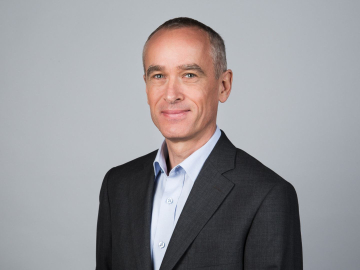Agility is (l)earned

Joseph Schumpeter coined this catchphrase to characterize market-based economies more than 100 years ago, but the acceleration of today’s product cycles and social practices, in particular in the field of communication, neatly confirms Schumpeter’s observation. Both in terms of creation and of destruction, executives seem exposed to increasing uncertainty about the future. How can they engrain a culture of “fail fast, learn fast” in their companies? How can they develop sustainable business models? How can they create an attractive workplace for the generation of millennials and digital natives, as well as for an aging workforce overburdened with the challenge of life-long learning?
In this dynamic market environment, innovation shifts into the spotlight of corporate strategy. The creation of “Chief Innovation Officers” in many companies may be interpreted as an attempt to formalize this change in mindset on an organizational level. Appointing a visionary and charismatic leader to that position is certainly helpful, but does not (immediately) change the corporate DNA. Rather, a cultural shift has to trickle down from top management to everyone in the company.
We want to share three observations, based on our own experiences frequently teaching in large and medium-sized firms as well as from interviews with executives that we conducted over the last three years.
Embracing new forms of innovation
First, the size of investments that top management allocates for innovation is, of course, a major determinant of the capabilities of survival of a firm. With no investments in innovation, legacy markets may be served for a couple of years to come, but blue oceans (uncontested market spaces) will be left untapped. However, driven by digitalization and globalization, not only does the “how much?” count but also the “how?”
Fortunately, corporate decision-makers can draw today on an entire toolbox of methods and practices to enhance innovation within their firms. With open innovation and crowdsourcing, the boundaries and silos of conventional, internal R&D units can be perforated. For example, a scientist in a research lab in Nairobi may work on a type of concrete that a construction company in Switzerland needs for reinforcing its bridges. Similarly, corporate accelerators and incubators may breed internal ideas or draw inspiration from outside sources. Startups that have neither failed nor survived on their own, for example, are sometimes integrated into larger firms, with their ideas being absorbed by the corporate innovation funnel.
In our experience, while multinational companies have understood the necessity for change, their efforts often evaporate in an “Innovation Theater,” as serial entrepreneur Steve Blank calls it – a marketing effort without lasting consequences for their current and future business lines. Many German “hidden champions” have realized that they can (and have to) complement their traditional revenue streams by offering service solutions related to their products. They have established innovation labs in places like Berlin, where they can attract a different crowd of employees and join a larger startup ecosystem. Some of them have launched incubators composed by representatives from the “old world,” internal innovators, and external specialists bringing in a different mindset and experiences.
By contrast, smaller companies venture more slowly into the global, digital innovation space. They could greatly benefit from expanding into new types of innovation, for example, via the thriving market of specialized providers of innovation services. It does not stretch a company’s budget excessively to become part of a consortium that sponsors an accelerator or to employ trend scouts in key world markets who can report back to headquarters what they observe, or to organize a hackathon, say, with the objective of developing an app for its products or services.
Customer-centricity: from “push” to “pull”
Our second observation is that even fairly traditional industries move from “technology push” to “market pull,” as one representative of a large chemical company described it to us. In his industry’s old world, a “technology push” consisted of a new, superior product that typically became the basis of a new market. According to him, existing technologies and chemicals can now cover almost everything that is needed. Instead of chemicals, future revenues will be generated by chemistry – a fundamentally different business model than just selling tons of substances. Understanding the market implies coming closer to clients; hence his company’s trend scouts actively search for new ideas on all continents.
The move from “push” to “pull” no longer stops at the doorstep of an executive’s office. Methods such as Design Thinking are used to train managers across hierarchies in a more customer-centric view. For example, how can a 50-year-old sales director of an insurance company know the mentality of a millennial, and why might representatives of Generation Y be uninterested in taking out insurance? An inconvenient but efficient way to explore this puzzle is to leave desk and office behind to speak directly with millennials. In our experience, middle managers especially struggle when we ask them to leave their comfort zone and enter the “learning zone” by walking in the streets and interviewing people they would never have contact within their private or professional lives. But those who are most skeptical and hesitant at the beginning of the exercise often return with plenty of stories and empathy for the interviewees they encountered.
The customers may not always be found in the streets – they can also be internal staff. For example, if a company suffers from too high employee turnover, a long questionnaire may provide statistical evidence but will hardly generate “customer journeys,” that is, real inquiries into an individual’s narrative of how the working environment is perceived and could potentially be improved. To generate in-depth knowledge about a person’s motivations, Design Thinking serves as a toolkit for these qualitative insights and provides instruments such as “shadowing,” where an employee is accompanied by an observer over a certain time period. Emotionally engaging with the “customer” is a prerequisite for innovation.
Networks of like-minded agents of change
Third, in our experience, the most difficult part of innovation is its implementation in daily corporate practices. After a crash course in Design Thinking, fully enthusiastic executives return to their offices and are quite often confronted with ignorance, organizational inertia, and arrogance vis-à-vis the newly acquired skills. Under these adverse circumstances, it greatly helps to establish a network among equal-minded innovators. As John Kotter claims in his book XLR8 (Accelerate), formal hierarchies can be circumvented by creating a parallel organization within the firm, a structure which he calls a “dual operating system.” For example, virtual exchange platforms and real meetups can be established to discuss organizational and mental barriers that are encountered during the change process. Alliances can be established beyond silos, and coalitions can be formed.
In hierarchical organizations, it definitely helps to obtain high-level approval and support for these initiatives. One of the most prominent examples of German multinationals with an innovative DNA is software giant SAP. One of the company’s five founders, Hasso Plattner, not only promotes the Design Thinking methodology within the organization, he also launched the Hasso Plattner Institute to provide a platform for teaching, practice, and research, similar to the famous d.school at Stanford University and its spin-offs.
Especially in traditional manufacturing industries, we have observed that innovations have a high likelihood to cross the “chasm of death” between pilot stage and successful commercialization if they are very early anchored in an existing business unit. That type of ownership stimulates identification and commitment, and the innovation evolves in close coordination with those who will later use it.
Our last finding deserves a word of caution: We recommend an incremental implementation of new innovation practices within organizations, in particular via a dual operating system. Unless markets have turned a company’s business model entirely upside down, the willingness to change is likely to remain limited among the bulk of employees. Implementing a full-fledged Design Thinking process to enhance customer-centricity or imposing a Scrum process on an entire business unit outside the IT sector is doomed to fail under most circumstances.
But no one can prevent you – as an agent of change – from personally cherry-picking some features of these methods and testing them with your team. The nucleus of creative destruction is not your company’s Chief Innovation Officer, it is you!

